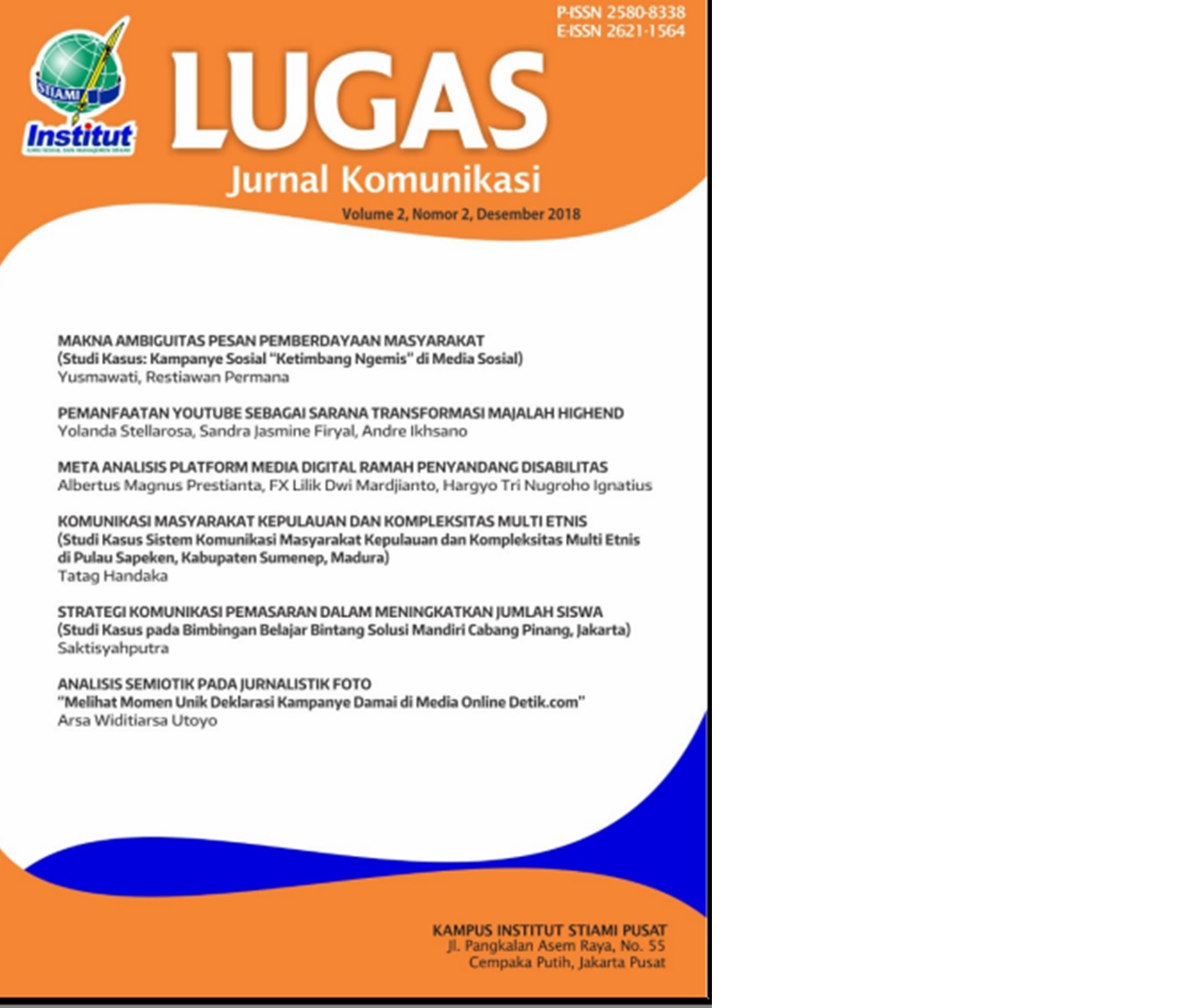Jurnalisme Online Pilkada Dki 2017 (Pendekatan Analisis isi Semantik Berita Online Pilkada Dki di detiknews)
DOI:
https://doi.org/10.31334/ljk.v1i2.444Keywords:
Online Journalism, The DKI Regional Election, Semantic Content Analysis, Jurnalisme Online, Pilkada DKI, Analisis Konten SemantikAbstract
The Second Round of the DKI Regional Election on April 19, 2017 was an important event that attract the attention of many parties. Online news has become one of the sources of news that many have been waiting for because of its unique characteristics; interactive, immediacy, multimedia capability and non-linearity. One of the main sources of online news is Detiknews. This study aims to examine all the news on Detiknews on the election day in the 2017 DKI elections using semantic content analysis. The methodology used is descriptive qualitative. The results of the study resulted in 3 semantic content classifications from 46 researched articles. The conclusions obtained from all Detiknews online news about the Second Round of the DKI Pilkada on April 19, 2019 are good at describing all the important events that occurred that day.
Babak Kedua Pemilihan Daerah DKI pada 19 April 2017 merupakan peristiwa penting yang menarik perhatian banyak pihak. Berita online telah menjadi salah satu sumber berita yang telah lama dinanti karena karakteristiknya yang unik; interaktif, kedekatan, kemampuan multimedia dan non-linearitas. Salah satu sumber utama berita online adalah Detiknews. Penelitian ini bertujuan untuk memeriksa semua berita tentang Detiknews pada hari pemilihan di Pemilu DKI 2017 menggunakan analisis konten semantik. Metodologi yang digunakan adalah deskriptif kualitatif. Hasil penelitian ini menghasilkan 3 klasifikasi konten semantik dari 46 artikel yang diteliti. Kesimpulan yang diperoleh dari semua berita online Detiknews tentang Putaran Kedua Pilkada DKI pada 19 April 2019 bagus untuk menggambarkan semua peristiwa penting yang terjadi hari itu.
References
Basri, H. 2014. Using qualitative research in accounting and management studies: not a new agenda.
Journal of US-China Public Administration, October 2014, Vol.11, No.10.
Bungin, Burhan. 2012. Penelitian Kualitatif; Komunikasi, Ekonomi, Kebijakan Publik, dan Ilmu Sosial lainnya. Kencana. Jakarta
Bulaeng, Andi. 2004. Metode Penelitian Komunikasi Kontemporer , Penerbit Andi. Yogyakarta
Cresswell, John W, 1994. Research Design: qualitative, quantitative and mixed method approaches, SAGE Publications
Hadari Nawawi, H. Murni Martini, 1966. Penelitian Terapan, Yogyakarta: GajahMada University Press,cet . 2
Hadi, I.P., 2010. Perkembangan teknologi komunikasi dalam era jurnalistik modern. Scriptura, 3(1), pp.69-84.
Hasfi, N., 2009. Tantangan Jurnalis di Era Globalisasi Informasi. In Forum.
Krippendorff, Klaus. 1991. Content Analysis: an introduction ot its Methodology, SAGE Publications.
Kriyantono. 2012. Public Relations & Crisis Management: Pendekatan Critical Public Relations Etnografi Kritis & Kualitatif. Jakarta: Kencana
McCusker, K., & Gunaydin, S. (2015). Research using qualitative, quantitative or mixed methods and
Choice based on the research. Mukhtar. 2013. Metode Penelitian Deskriftif Kualitatif. Jakarta : GP Press Group
Soehartono, Irawan, 1999. Metode Penelitian Sosial, PT. Remaja Rosda Karya,Bandung
Objektivitas Berita Pada Media dalam Jaringan. (Analisis Isi Berita Pemilihan Gubernur DKI Jakarta pada Detiknews selama Masa Kampanye Periode I) Vience Mutiara RumataPuslitbang APTIKA-IKP, Kementerian Komunikasi dan Informatika
Metode Penelitian Kualitatif Analisis Teks. Tugas Mata Kuliah Metodologi Penelitian Komunikasi II. Zatul Fadli dkk. Magister Ilmu Komunikasi. Fakultas Ilmu Sosial dan Politik, Universitas Sumatera Utara. 2016
//chyrun.com/peringkat-5-media-online-populer-di-indonesia-beserta-pendapatanya/
//www.academia.edu/24311918/
//news.okezone.com/read/2017/03/04/338/1634341/ini-hasil-pilgub-dki-putaran-pertama
//megapolitan.kompas.com/read/2017/04/30/06030941/ini.hasil.rekapitulasi.suara.putaran.kedua.pilkada.dki.jakarta
Downloads
Published
Issue
Section
License

This work is licensed under a Creative Commons Attribution-NonCommercial-ShareAlike 4.0 International License.
Copyright Notice
Please find the rights and licenses in LUGAS Jurnal Komunikasi, spirit is to disseminate articles published are as free as possible. Under the Creative Commons license, LUGAS Jurnal Komunikasi permits users to copy, distribute, display, and perform the work for non-commercial purposes only. Users will also need to attribute authors and LUGAS Jurnal Komunikasion distributing works in the journal and other media of publications.
4.Co-Authorship
If the article was jointly prepared by more than one author, any authors submitting the manuscript warrants that he/she has been authorized by all co-authors to be agreed on this copyright and license notice (agreement) on their behalf, and agrees to inform his/her co-authors of the terms of this policy. LUGAS Jurnal Komunikasi will not be held liable for anything that may arise due to the author(s) internal dispute. LUGAS Jurnal Komunikasi will only communicate with the corresponding author.
5.Miscellaneous
LUGAS Jurnal Komunikasi will publish the article (or have it published) in the journal if the article’s editorial process is successfully completed. LUGAS Jurnal Komunikasi editors may modify the article to a style of punctuation, spelling, capitalization, referencing and usage that deems appropriate. The author acknowledges that the article may be published so that it will be publicly accessible and such access will be free of charge for the readers as mentioned in point 3.
Every accepted manuscript should be accompanied by "Copyright Transfer Agreement" prior to the article publication.





.png)

